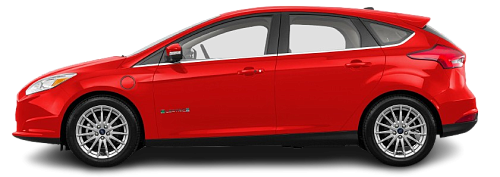USA EV Comparison: BYD Seal Design RWD vs Ford Focus Electric 33 kWh
Struggling to Decide? Let AI Help!
Your AI Summary Is Ready!
General Info
While the BYD Seal Design RWD (2022-…) is currently produced, it is not offered for sale in the United States. The Ford Focus Electric 33 kWh (2017-2018) has been discontinued. You can find it for as low as $6898 on the used car market.
The BYD Seal Design RWD (2022-…) is a Sedan, whereas the Ford Focus Electric 33 kWh (2017-2018) is a Hatchback.
| Property | BYD Seal Design RWD | Ford Focus Electric 33 kWh |
|---|---|---|
| Years of Production | 2022-… | 2017-2018 |
| Current Status | Produced | Discontinued |
| Country of Manufacture | China | Germany, USA |
| Body Style | Sedan | Hatchback |
| Market Availability | EU | EU, USA |
| Price USA (Used) | - Price USA (Used) | $6898 |
| GCC Score | 6.5 | 4.2 |
Range and Efficiency
The BYD Seal Design RWD (2022-…) boasts a greater real-world range, a larger battery, and superior energy efficiency compared to the Ford Focus Electric 33 kWh (2017-2018).
| Property | BYD Seal Design RWD | Ford Focus Electric 33 kWh |
|---|---|---|
| Range (EPA) | - Range (EPA) | 115 mi |
| Range (WLTP) | 354 mi | - Range (WLTP) |
| Range (GCC) | 301 mi | 107 mi |
| Battery Capacity (Nominal) | 84 kWh | 33.5 kWh |
| Battery Capacity (Usable) | 82.5 kWh | 31.8 kWh |
| Efficiency per 100 mi | 27.4 kWh/100 mi | 29.7 kWh/100 mi |
| Efficiency per kWh | 3.65 mi/kWh | 3.36 mi/kWh |
| Range and Efficiency Score | 8.2 | 4.5 |
Charging
Both vehicles utilize a standard 400-volt architecture.
The BYD Seal Design RWD (2022-…) offers faster charging speeds at DC stations, reaching up to 150 kW, while the Ford Focus Electric 33 kWh (2017-2018) maxes out at 50 kW.
The BYD Seal Design RWD (2022-…) features a more powerful on-board charger, supporting a maximum AC charging power of 11 kW, whereas the Ford Focus Electric 33 kWh (2017-2018) is limited to 6.6 kW.
| Property | BYD Seal Design RWD | Ford Focus Electric 33 kWh |
|---|---|---|
| Max Charging Power (AC) | 11 kW | 6.6 kW |
| Max Charging Power (DC) | 150 kW | 50 kW |
| Architecture | 400 V | 400 V |
| Charge Port | CCS Type 2 | CCS Type 1 |
| Charging Score | 6.5 | 3.5 |
Performance
The BYD Seal Design RWD (2022-…) is rear-wheel drive, while the Ford Focus Electric 33 kWh (2017-2018) offers a front-wheel drive system.
The BYD Seal Design RWD (2022-…) boasts greater motor power and accelerates faster from 0 to 60 mph.
| Property | BYD Seal Design RWD | Ford Focus Electric 33 kWh |
|---|---|---|
| Drive Type | RWD | FWD |
| Motor Type | PMSM | PMSM |
| Motor Power (kW) | 230 kW | 107 kW |
| Motor Power (hp) | 308 hp | 143 hp |
| Motor Torque | 266 lb-ft | 184 lb-ft |
| 0-60 mph | 5.7 s | 11 s |
| Top Speed | 112 mph | 84 mph |
| Performance Score | 4.5 | 2.2 |
Dimensions
The BYD Seal Design RWD (2022-…) is longer, but has a similar width and height to the Ford Focus Electric 33 kWh (2017-2018).
The BYD Seal Design RWD (2022-…) boasts a more extended wheelbase.
| Property | BYD Seal Design RWD | Ford Focus Electric 33 kWh |
|---|---|---|
| Length | 189 in | 172.9 in |
| Width (with Mirrors) | 84.6 in | 80.5 in |
| Width (w/o Mirrors) | 73.8 in | 74.1 in |
| Height | 57.5 in | 58.2 in |
| Wheelbase | 115 in | 104.3 in |
Cargo and Towing
A frunk (front trunk) is available in the BYD Seal Design RWD (2022-…), but the Ford Focus Electric 33 kWh (2017-2018) doesn’t have one.
The BYD Seal Design RWD (2022-…) has a towing capacity of up to 1653 lb, whereas the Ford Focus Electric 33 kWh (2017-2018) is not officially rated for towing in the US.
| Property | BYD Seal Design RWD | Ford Focus Electric 33 kWh |
|---|---|---|
| Number of Seats | 5 | 5 |
| Curb Weight | 4597 lb | 3640 lb |
| Cargo Volume (Trunk) | 14.1 ft3 | 14.2 ft3 |
| Cargo Volume (Max) | - Cargo Volume (Max) | 33.2 ft3 |
| Cargo Volume (Frunk) | 1.9 ft3 | - Cargo Volume (Frunk) |
| Towing Capacity | 1653 lb | - Towing Capacity |
| Cargo and Towing Score | 5.3 | 4.1 |




